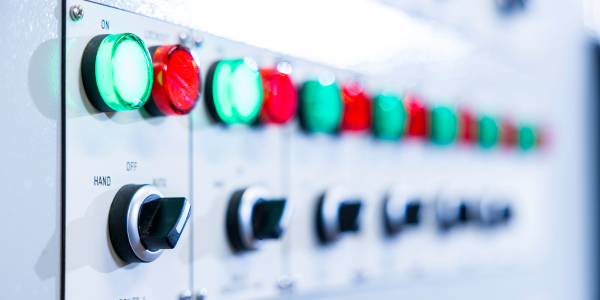As buildings become smarter, more energy-efficient and subject to stricter reporting requirements, building automation systems (BAS) are no longer optional. The best building automation systems can optimise energy use, improve occupant comfort, reduce maintenance costs and support ESG targets. With a wide range of platforms available, each claiming to be the most advanced or comprehensive, it can be difficult to identify which system is right for your specific requirements.
In this guide, we explain what to look for in a BAS, compare some of the best building automation systems available and highlight the features that experienced building automation companies like Cube Controls prioritise in real-world installations.
If you need help specifying or integrating a BAS for your facilities, get in touch with Cube Controls for independent, technically informed advice.
What Is a Building Automation System?
A building automation system connects and controls key building functions such as HVAC (heating, ventilation and air conditioning), lighting, energy metering, access control and fire safety. It uses a central platform to monitor performance and automate routine tasks.
Most systems support open protocols, which are standardised methods that allow appliances to communicate and work together. These appliances might include HVAC controllers, lighting sensors, thermostats, energy meters and access panels. Common protocols like BACnet, KNX and Modbus enable this equipment to share data and function as part of a coordinated system.
For a more detailed overview, read our guide to building automation control systems.
Which Building Automation System Is Best? What to Look For
When evaluating the best building automation systems, focus on how well each system fits the specific needs of your building, not just the headline features. Cube Controls has worked on hundreds of BAS projects across commercial, public and industrial buildings. Based on our experience, the following areas consistently determine long-term success:
- Integration capability: The system should support open protocols such as BACnet, KNX or Modbus, enabling it to connect reliably with HVAC, lighting controls, metering, security and fire safety systems.
- Ease of use: Interfaces should be practical and accessible, with real-time dashboards, remote access and clear control layers. Systems that need external support for daily adjustments tend to create avoidable delays and add cost.
- Data and reporting: A reliable BAS provides transparent reporting on energy use, equipment status and performance trends. This data is essential for energy efficiency, fault detection and compliance with ESG frameworks.
- Scalability: The platform should allow for future system expansion or site changes without major redesign. Systems with open architecture can be adapted over time without being tied to a single manufacturer. Open architecture systems support standard protocols and work with a wide range of appliances, making it easier to upgrade, expand or integrate new features when needed.
- Security and support: Look for platforms that include role-based access, where each user can see or control only what’s relevant to their role. Combined with regular updates and clear technical documentation, this helps maintain security and day-to-day reliability.
“Most systems look the same on paper. What matters is how they perform once installed. How quickly are issues resolved? Is the data clear enough for non-specialists? Can your team run it without needing outside help for basic tasks? That’s where the real difference is.”
— Tony Williams, Director & Founder, Cube Controls
The best building automation systems support long-term performance, not just initial functionality. Cube Controls specifies and integrates future-ready systems, support open standards and meet the practical needs of both facilities teams and building owners.
Our Expert Opinion: What Are the Top 5 Building Automation Systems?
From Cube Controls’ perspective, the best building automation systems are designed to maintain stable control and adapt to changing building demands over time. We work with these systems every day, not just in theory, but through live installations, retrofits and complex integration projects.
These five systems (in alphabetical order) are consistently reliable in practice. Each one has distinct strengths in areas such as user interface, integration flexibility, long-term support and scalability.
1. Distech Controls
Distech Controls is well suited to smart buildings and modern commercial environments where integration with IoT, cloud platforms and third-party APIs is required. Its open ECLYPSE™ platform supports advanced digital infrastructure, allowing building managers to achieve greater efficiency, a clearer understanding of a building’s overall energy use, in addition to prioritising occupant comfort.
We’ve nominated it here in our best building automation systems list for its forward-thinking technology and ability to support complex digital environments.
2. Priva
Priva’s extensive macro library allows Cube engineers to configure HVAC systems quickly and accurately, covering almost any plant layout. This reduces design time and helps control installation costs. For projects needing more advanced optimisation, Priva’s ecoBuilding platform adds a cloud-based AI layer that manages energy performance beyond what standard BAS logic can deliver.
Priva is included here owing to its speed of deployment, comprehensive configuration tools and cloud-enabled energy optimisation.
3. CentraLine
CentraLine is a strong choice for commercial, public and mixed-use buildings that require reliable integration and a clear path for future upgrades. It’s well suited to estates with existing Honeywell infrastructure. The system supports multiple open protocols (Modbus, M-BUS and LONWORKS), works with third-party appliances and includes a DALI64 lighting control system, as well as energy-saving features.
It earns a place in our top five for its balance of open integration, energy performance and long-term manufacturer-backed support.
4. Trend
Trend is widely used in education, healthcare, commercial and public buildings where consistent environmental control and proven reliability are essential. Its scalable systems can handle everything from small standalone buildings to complex, multi-site estates. With precise control of HVAC and other building services, Trend systems help reduce energy use, maintain occupant comfort and minimise maintenance overheads.
Based on our experience, Trend’s broad applicability and strong energy performance earns it a place in our top five systems.
5. Tridium (Niagara Framework)
Tridium’s Niagara Framework is a powerful software platform used in complex buildings, multi-system environments and estate-wide integration projects. It connects and manages diverse appliances, including HVAC, lighting, energy, metering and more, using an open framework and an open distribution model. Niagara enables building owners to extract and act on real-time data from across their assets through a single, scalable interface.
It’s in our top five for its ability to extract value and insight from real-time operational data, giving facilities and building managers a clear, central view of how their systems are performing.
These five systems have earned their place among the best building automation systems based on real-world performance, flexibility and long-term value. Each one is backed by Cube Contols’ technical expertise and direct partnership*, ensuring the right fit for each building and ongoing support beyond installation.
We also work with a wider range of systems and components, including Belimo, Danfoss, LoRaWAN and IoT, Open System Solutions, Rako, Sontay, and Synapsys. Get in touch to discuss the most appropriate solution for your building.
Trends Shaping Different Types of Building Automation Systems
The role of building automation systems continues to shift from passive control to active optimisation. In Cube’s recent projects, we’ve seen a clear move towards platforms that not only manage systems efficiently but also enable smarter decision-making through data.
Key developments include:
- Real-time performance monitoring: Building operators are prioritising systems that provide live data on energy use, occupancy and equipment status. This supports faster fault response and more accurate reporting.
- Integration with cloud services and APIs: More clients are asking for systems that can connect with cloud-based analytics, asset management tools or third-party applications, not just internal BAS functions.
- Increased use of wireless and IoT sensors: LoRaWAN and other wireless technologies are being used to add sensing and control in places where cabling is impractical or cost-prohibitive.
- More granular user control: Systems are being specified with flexible user access, zone-level controls and dashboards tailored to different roles within the organisation.
The best building automation systems are being selected not just for what they control, but for how easily they can surface actionable insights and support wider operational goals.
Choosing the Best Building Automation System Starts with the Right Advice
Selecting a building automation system is no longer just about HVAC control. It’s about supporting energy targets, reducing downtime, improving user comfort and giving facilities teams the tools they need to manage complexity. Over the next few years, we expect to see more emphasis on systems that integrate directly with ESG reporting tools, offer full remote access as standard and support predictive maintenance using live operational data. The shift will continue toward flexible platforms that allow building automation companies like Cube Controls to tailor solutions without locking clients into fixed hardware or limited functionality.
At Cube Controls, we work with the best building automation systems on the market, but we don’t recommend them by default. Every system we specify is chosen based on building type, project goals, existing infrastructure and long-term operational needs.
To find out which system is right for your building, get in touch with Cube Controls. We’ll help you assess the options and design a control strategy that delivers measurable results.
*Cube Controls is an approved partner for the systems featured in this list. We include them here based on practical performance across real projects, but we believe it’s important to be transparent about our ongoing relationships with these providers.
Cube Controls is an established and experienced supplier of Building Management Systems, specialising in the design and set up of bespoke environmental and energy control programmes for commercial buildings and property.
To find out how Cube Controls can support you at all stages of design and consultancy, installation and modification and maintenance of your building management systems contact our expert and friendly team on 01903 694279 or sales@cubecontrols.co.uk.




